An Analysis of Demand, Supply, and Economic Theories in Business
VerifiedAdded on 2023/06/10
|13
|3403
|253
Report
AI Summary
This report analyzes the laws of demand and supply, including movements and shifts in their respective curves, within the context of contemporary business economics, using Next plc as an example. It discusses how changes in price, income, consumer preferences, and production costs affect demand and supply. Furthermore, the report compares and contrasts economic theories, such as Adam Smith's and Keynesian economics, relating them to modern business activities, highlighting the role of labor, government intervention, and macroeconomic factors in shaping economic growth and market dynamics. Desklib provides students access to similar solved assignments and past papers for comprehensive study support.
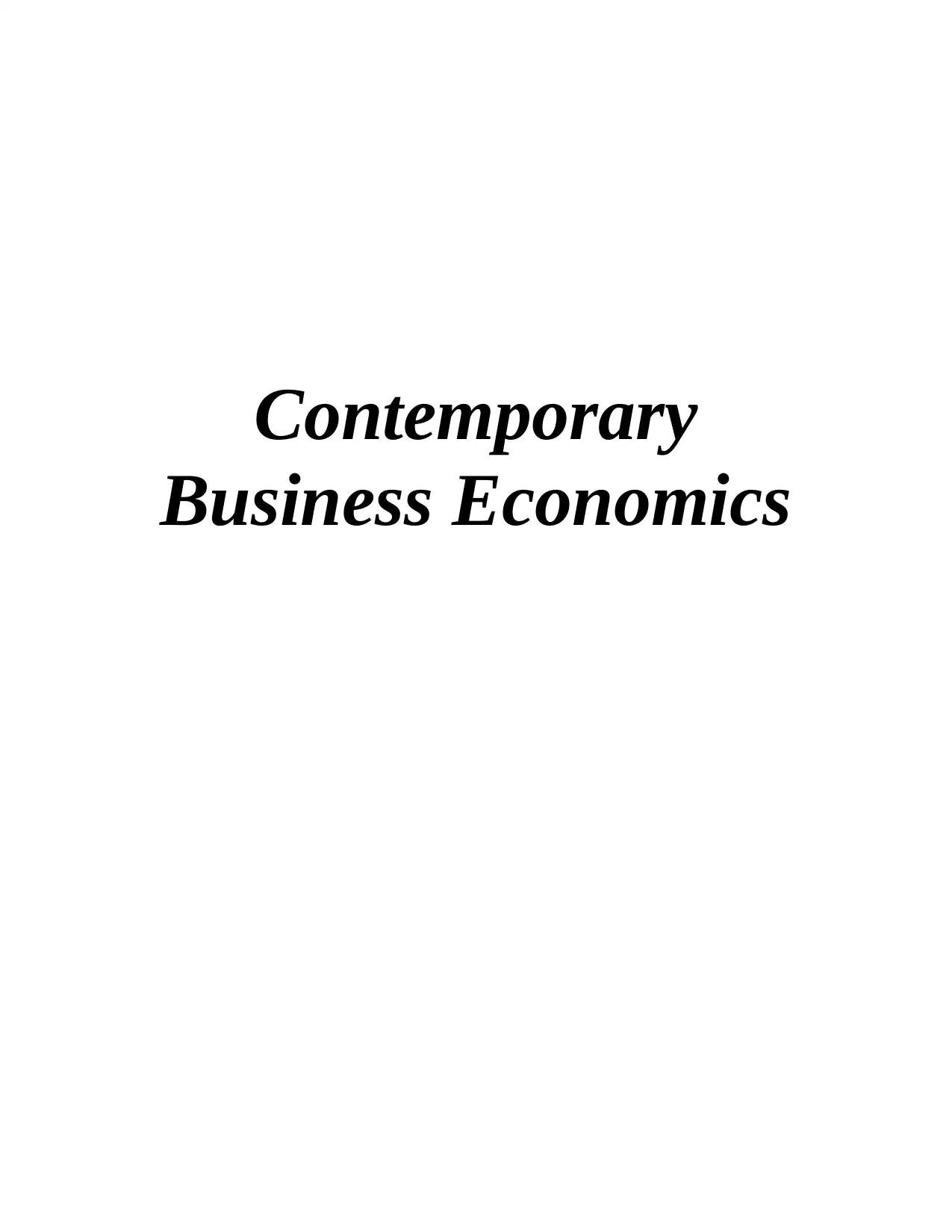
Contemporary
Business Economics
Business Economics
Paraphrase This Document
Need a fresh take? Get an instant paraphrase of this document with our AI Paraphraser
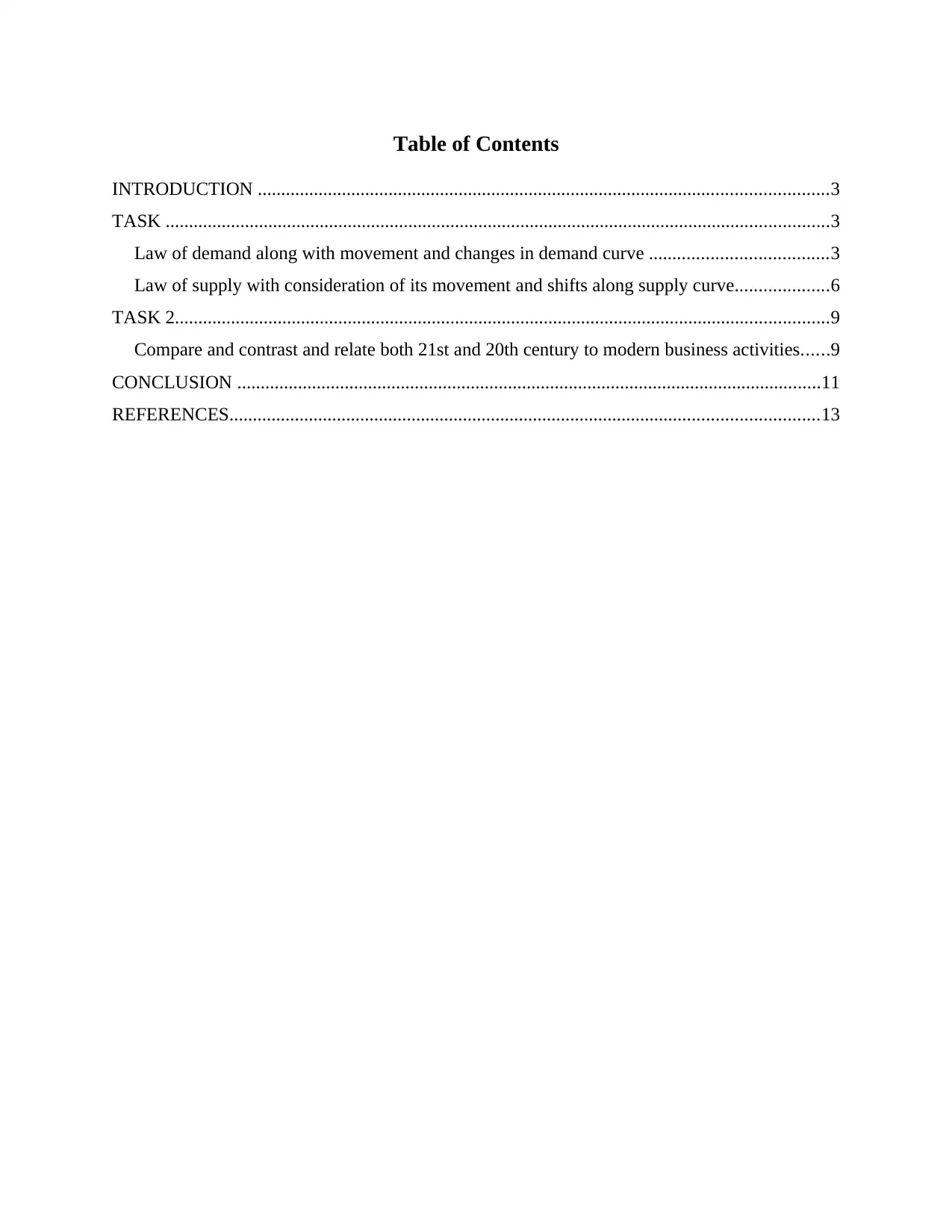
Table of Contents
INTRODUCTION ..........................................................................................................................3
TASK ..............................................................................................................................................3
Law of demand along with movement and changes in demand curve ......................................3
Law of supply with consideration of its movement and shifts along supply curve....................6
TASK 2............................................................................................................................................9
Compare and contrast and relate both 21st and 20th century to modern business activities......9
CONCLUSION .............................................................................................................................11
REFERENCES..............................................................................................................................13
INTRODUCTION ..........................................................................................................................3
TASK ..............................................................................................................................................3
Law of demand along with movement and changes in demand curve ......................................3
Law of supply with consideration of its movement and shifts along supply curve....................6
TASK 2............................................................................................................................................9
Compare and contrast and relate both 21st and 20th century to modern business activities......9
CONCLUSION .............................................................................................................................11
REFERENCES..............................................................................................................................13
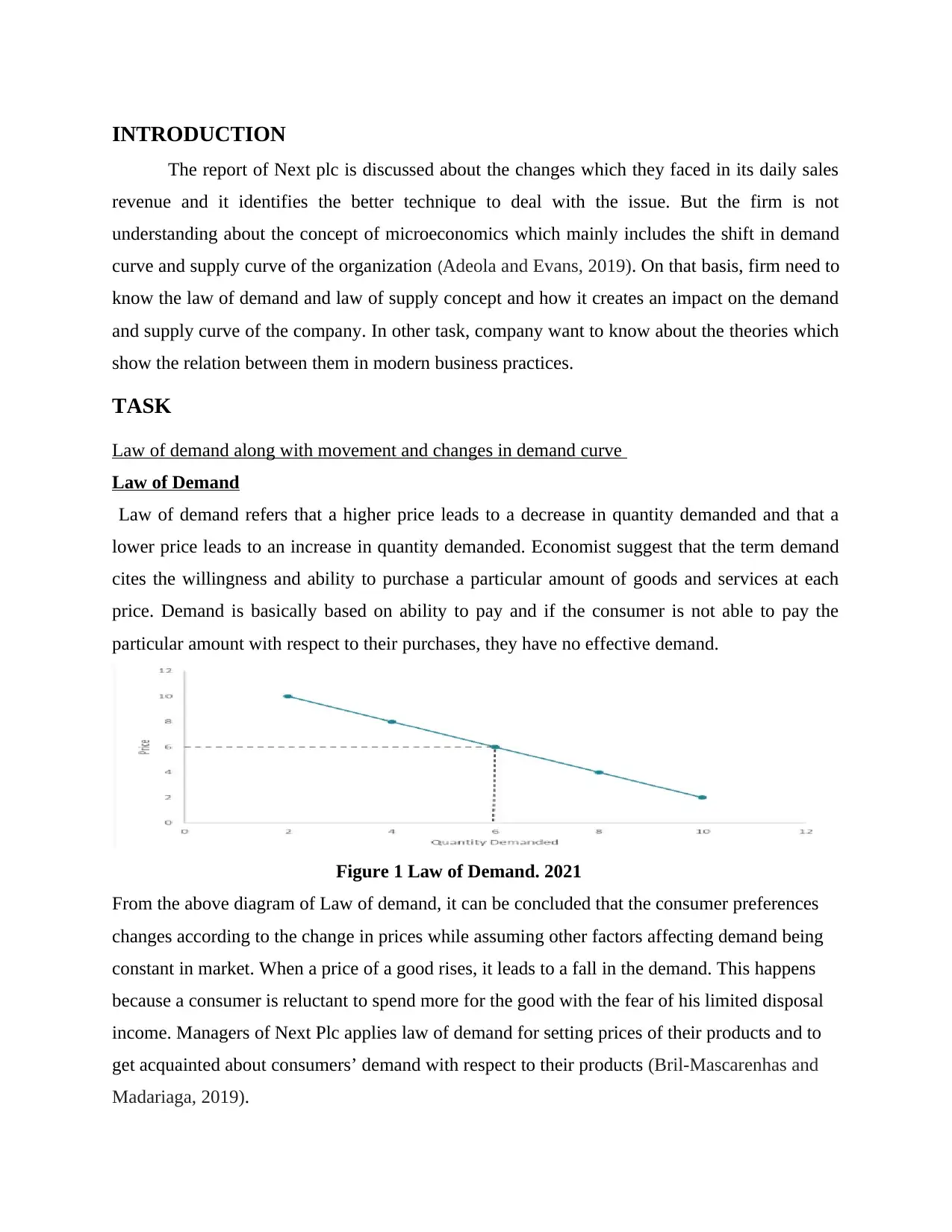
INTRODUCTION
The report of Next plc is discussed about the changes which they faced in its daily sales
revenue and it identifies the better technique to deal with the issue. But the firm is not
understanding about the concept of microeconomics which mainly includes the shift in demand
curve and supply curve of the organization (Adeola and Evans, 2019). On that basis, firm need to
know the law of demand and law of supply concept and how it creates an impact on the demand
and supply curve of the company. In other task, company want to know about the theories which
show the relation between them in modern business practices.
TASK
Law of demand along with movement and changes in demand curve
Law of Demand
Law of demand refers that a higher price leads to a decrease in quantity demanded and that a
lower price leads to an increase in quantity demanded. Economist suggest that the term demand
cites the willingness and ability to purchase a particular amount of goods and services at each
price. Demand is basically based on ability to pay and if the consumer is not able to pay the
particular amount with respect to their purchases, they have no effective demand.
Figure 1 Law of Demand. 2021
From the above diagram of Law of demand, it can be concluded that the consumer preferences
changes according to the change in prices while assuming other factors affecting demand being
constant in market. When a price of a good rises, it leads to a fall in the demand. This happens
because a consumer is reluctant to spend more for the good with the fear of his limited disposal
income. Managers of Next Plc applies law of demand for setting prices of their products and to
get acquainted about consumers’ demand with respect to their products (Bril-Mascarenhas and
Madariaga, 2019).
The report of Next plc is discussed about the changes which they faced in its daily sales
revenue and it identifies the better technique to deal with the issue. But the firm is not
understanding about the concept of microeconomics which mainly includes the shift in demand
curve and supply curve of the organization (Adeola and Evans, 2019). On that basis, firm need to
know the law of demand and law of supply concept and how it creates an impact on the demand
and supply curve of the company. In other task, company want to know about the theories which
show the relation between them in modern business practices.
TASK
Law of demand along with movement and changes in demand curve
Law of Demand
Law of demand refers that a higher price leads to a decrease in quantity demanded and that a
lower price leads to an increase in quantity demanded. Economist suggest that the term demand
cites the willingness and ability to purchase a particular amount of goods and services at each
price. Demand is basically based on ability to pay and if the consumer is not able to pay the
particular amount with respect to their purchases, they have no effective demand.
Figure 1 Law of Demand. 2021
From the above diagram of Law of demand, it can be concluded that the consumer preferences
changes according to the change in prices while assuming other factors affecting demand being
constant in market. When a price of a good rises, it leads to a fall in the demand. This happens
because a consumer is reluctant to spend more for the good with the fear of his limited disposal
income. Managers of Next Plc applies law of demand for setting prices of their products and to
get acquainted about consumers’ demand with respect to their products (Bril-Mascarenhas and
Madariaga, 2019).
⊘ This is a preview!⊘
Do you want full access?
Subscribe today to unlock all pages.

Trusted by 1+ million students worldwide
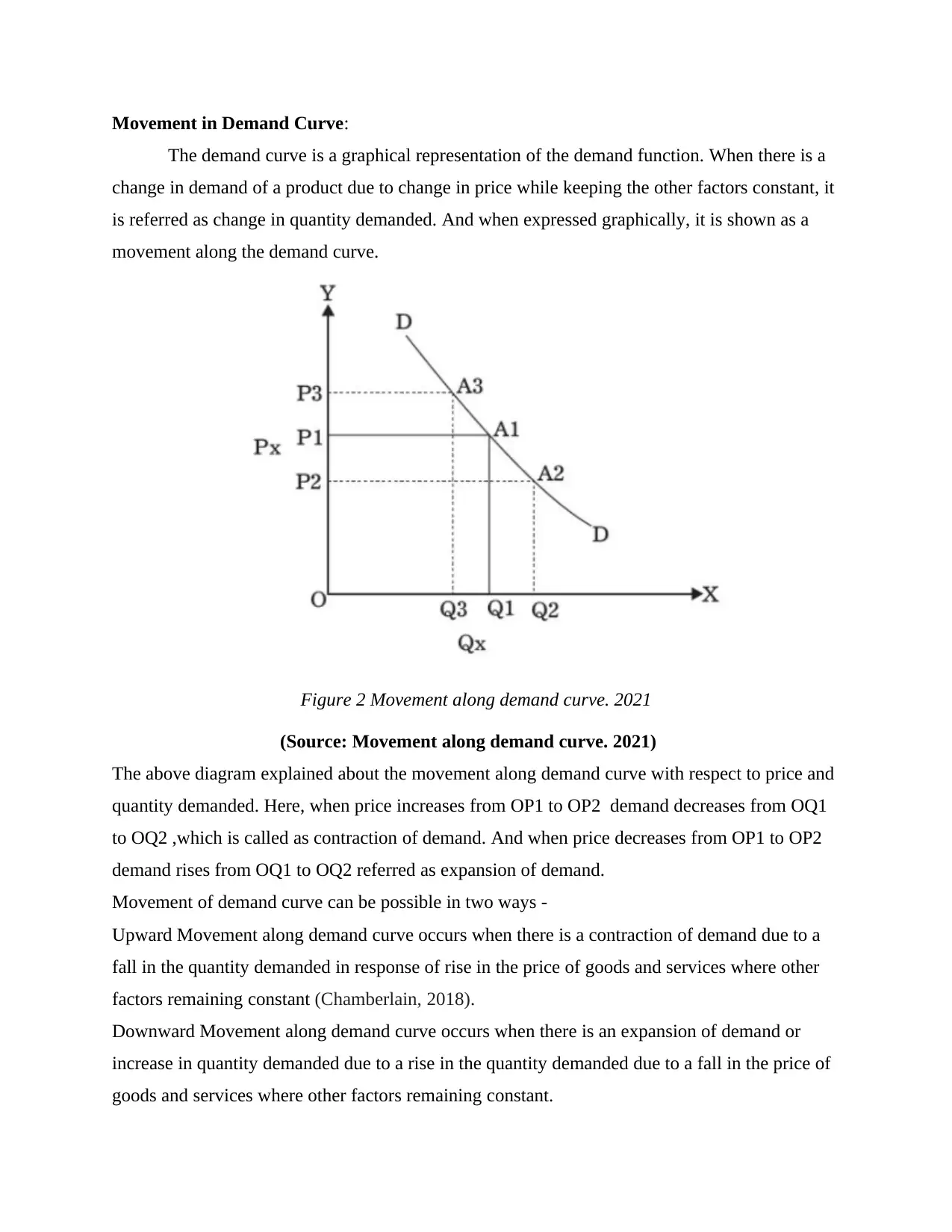
Movement in Demand Curve:
The demand curve is a graphical representation of the demand function. When there is a
change in demand of a product due to change in price while keeping the other factors constant, it
is referred as change in quantity demanded. And when expressed graphically, it is shown as a
movement along the demand curve.
Figure 2 Movement along demand curve. 2021
(Source: Movement along demand curve. 2021)
The above diagram explained about the movement along demand curve with respect to price and
quantity demanded. Here, when price increases from OP1 to OP2 demand decreases from OQ1
to OQ2 ,which is called as contraction of demand. And when price decreases from OP1 to OP2
demand rises from OQ1 to OQ2 referred as expansion of demand.
Movement of demand curve can be possible in two ways -
Upward Movement along demand curve occurs when there is a contraction of demand due to a
fall in the quantity demanded in response of rise in the price of goods and services where other
factors remaining constant (Chamberlain, 2018).
Downward Movement along demand curve occurs when there is an expansion of demand or
increase in quantity demanded due to a rise in the quantity demanded due to a fall in the price of
goods and services where other factors remaining constant.
The demand curve is a graphical representation of the demand function. When there is a
change in demand of a product due to change in price while keeping the other factors constant, it
is referred as change in quantity demanded. And when expressed graphically, it is shown as a
movement along the demand curve.
Figure 2 Movement along demand curve. 2021
(Source: Movement along demand curve. 2021)
The above diagram explained about the movement along demand curve with respect to price and
quantity demanded. Here, when price increases from OP1 to OP2 demand decreases from OQ1
to OQ2 ,which is called as contraction of demand. And when price decreases from OP1 to OP2
demand rises from OQ1 to OQ2 referred as expansion of demand.
Movement of demand curve can be possible in two ways -
Upward Movement along demand curve occurs when there is a contraction of demand due to a
fall in the quantity demanded in response of rise in the price of goods and services where other
factors remaining constant (Chamberlain, 2018).
Downward Movement along demand curve occurs when there is an expansion of demand or
increase in quantity demanded due to a rise in the quantity demanded due to a fall in the price of
goods and services where other factors remaining constant.
Paraphrase This Document
Need a fresh take? Get an instant paraphrase of this document with our AI Paraphraser

Shift in Demand Curve
A shift in demand curve occurs due to favourable and unfavourable factors such as price
of substitute goods, price of complement goods,increase or decrease in incomes, tastes and
preferences, seasonal factors, fashion changes advertising campaign, etc., where price remains
constant. The position of the demand curve shifts in two directions that is leftward and upward
direction.
Rightward shift- If the factors causes demand to increase, the curve shifts to the right. It may
happen due to the rise in income when buyers will buy more of everything, even though the price
is constant (Denicolai, Zucchella and Magnani, 2021).
Leftward shift- If the factors causes demand to drop, the curve shift to the left which means
demand of goods and services are less. This happens due to many reasons for example: when the
income of buyer drops during a recession period, they will buy less of everything, even if the
price remain constant.
Figure 3 Shift in demand curve. 2021
(Source: Shift in demand curve. 2021)
A shift in demand curve occurs due to favourable and unfavourable factors such as price
of substitute goods, price of complement goods,increase or decrease in incomes, tastes and
preferences, seasonal factors, fashion changes advertising campaign, etc., where price remains
constant. The position of the demand curve shifts in two directions that is leftward and upward
direction.
Rightward shift- If the factors causes demand to increase, the curve shifts to the right. It may
happen due to the rise in income when buyers will buy more of everything, even though the price
is constant (Denicolai, Zucchella and Magnani, 2021).
Leftward shift- If the factors causes demand to drop, the curve shift to the left which means
demand of goods and services are less. This happens due to many reasons for example: when the
income of buyer drops during a recession period, they will buy less of everything, even if the
price remain constant.
Figure 3 Shift in demand curve. 2021
(Source: Shift in demand curve. 2021)
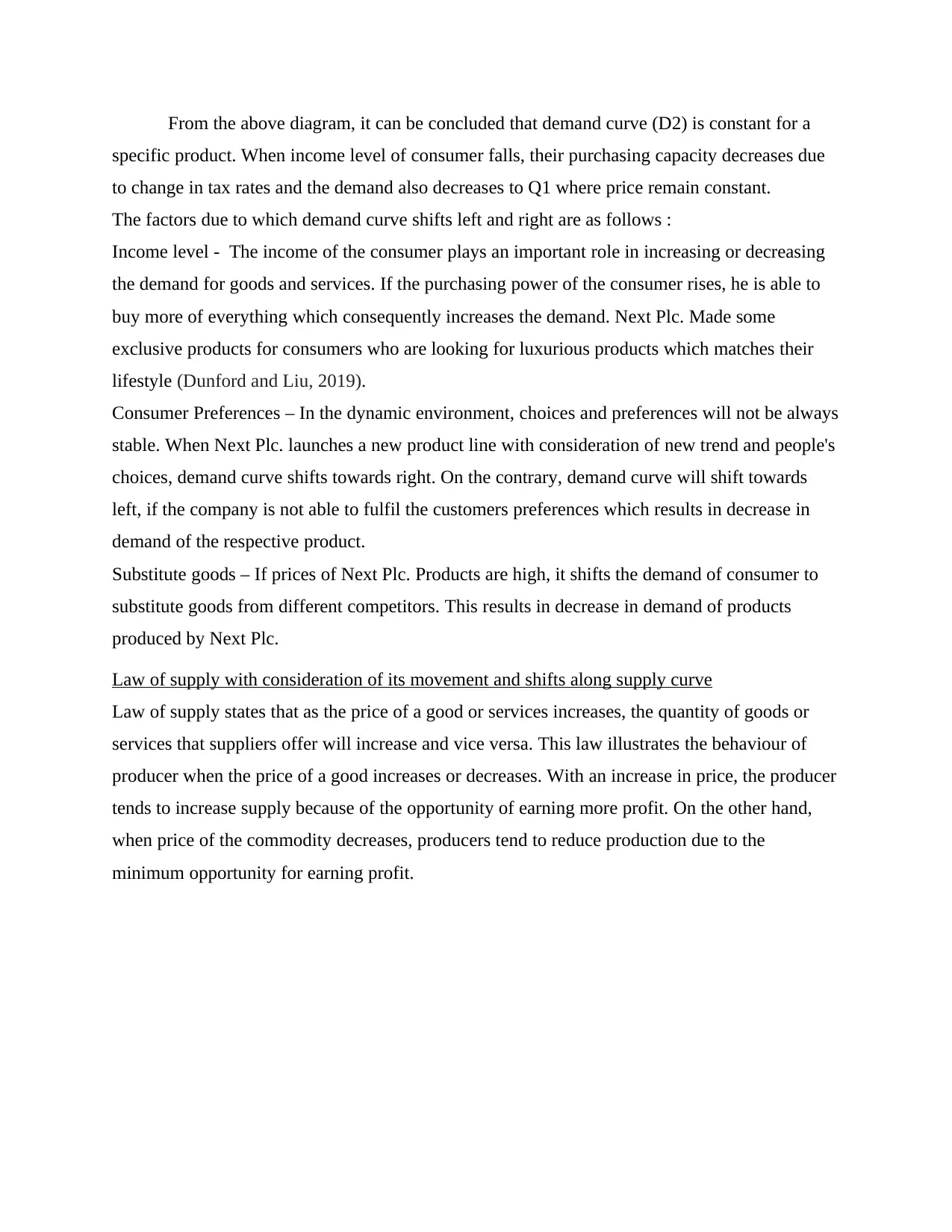
From the above diagram, it can be concluded that demand curve (D2) is constant for a
specific product. When income level of consumer falls, their purchasing capacity decreases due
to change in tax rates and the demand also decreases to Q1 where price remain constant.
The factors due to which demand curve shifts left and right are as follows :
Income level - The income of the consumer plays an important role in increasing or decreasing
the demand for goods and services. If the purchasing power of the consumer rises, he is able to
buy more of everything which consequently increases the demand. Next Plc. Made some
exclusive products for consumers who are looking for luxurious products which matches their
lifestyle (Dunford and Liu, 2019).
Consumer Preferences – In the dynamic environment, choices and preferences will not be always
stable. When Next Plc. launches a new product line with consideration of new trend and people's
choices, demand curve shifts towards right. On the contrary, demand curve will shift towards
left, if the company is not able to fulfil the customers preferences which results in decrease in
demand of the respective product.
Substitute goods – If prices of Next Plc. Products are high, it shifts the demand of consumer to
substitute goods from different competitors. This results in decrease in demand of products
produced by Next Plc.
Law of supply with consideration of its movement and shifts along supply curve
Law of supply states that as the price of a good or services increases, the quantity of goods or
services that suppliers offer will increase and vice versa. This law illustrates the behaviour of
producer when the price of a good increases or decreases. With an increase in price, the producer
tends to increase supply because of the opportunity of earning more profit. On the other hand,
when price of the commodity decreases, producers tend to reduce production due to the
minimum opportunity for earning profit.
specific product. When income level of consumer falls, their purchasing capacity decreases due
to change in tax rates and the demand also decreases to Q1 where price remain constant.
The factors due to which demand curve shifts left and right are as follows :
Income level - The income of the consumer plays an important role in increasing or decreasing
the demand for goods and services. If the purchasing power of the consumer rises, he is able to
buy more of everything which consequently increases the demand. Next Plc. Made some
exclusive products for consumers who are looking for luxurious products which matches their
lifestyle (Dunford and Liu, 2019).
Consumer Preferences – In the dynamic environment, choices and preferences will not be always
stable. When Next Plc. launches a new product line with consideration of new trend and people's
choices, demand curve shifts towards right. On the contrary, demand curve will shift towards
left, if the company is not able to fulfil the customers preferences which results in decrease in
demand of the respective product.
Substitute goods – If prices of Next Plc. Products are high, it shifts the demand of consumer to
substitute goods from different competitors. This results in decrease in demand of products
produced by Next Plc.
Law of supply with consideration of its movement and shifts along supply curve
Law of supply states that as the price of a good or services increases, the quantity of goods or
services that suppliers offer will increase and vice versa. This law illustrates the behaviour of
producer when the price of a good increases or decreases. With an increase in price, the producer
tends to increase supply because of the opportunity of earning more profit. On the other hand,
when price of the commodity decreases, producers tend to reduce production due to the
minimum opportunity for earning profit.
⊘ This is a preview!⊘
Do you want full access?
Subscribe today to unlock all pages.

Trusted by 1+ million students worldwide
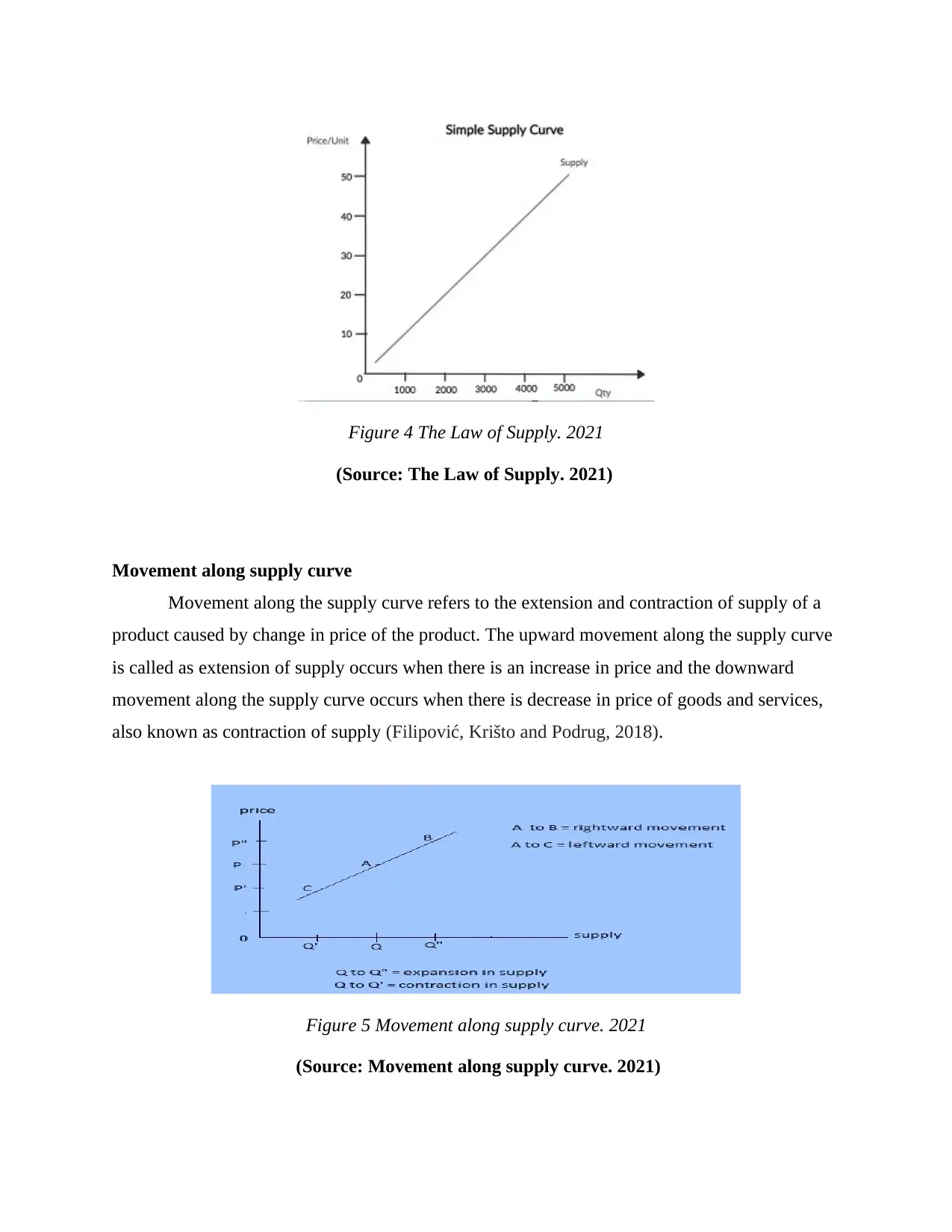
Figure 4 The Law of Supply. 2021
(Source: The Law of Supply. 2021)
Movement along supply curve
Movement along the supply curve refers to the extension and contraction of supply of a
product caused by change in price of the product. The upward movement along the supply curve
is called as extension of supply occurs when there is an increase in price and the downward
movement along the supply curve occurs when there is decrease in price of goods and services,
also known as contraction of supply (Filipović, Krišto and Podrug, 2018).
Figure 5 Movement along supply curve. 2021
(Source: Movement along supply curve. 2021)
(Source: The Law of Supply. 2021)
Movement along supply curve
Movement along the supply curve refers to the extension and contraction of supply of a
product caused by change in price of the product. The upward movement along the supply curve
is called as extension of supply occurs when there is an increase in price and the downward
movement along the supply curve occurs when there is decrease in price of goods and services,
also known as contraction of supply (Filipović, Krišto and Podrug, 2018).
Figure 5 Movement along supply curve. 2021
(Source: Movement along supply curve. 2021)
Paraphrase This Document
Need a fresh take? Get an instant paraphrase of this document with our AI Paraphraser
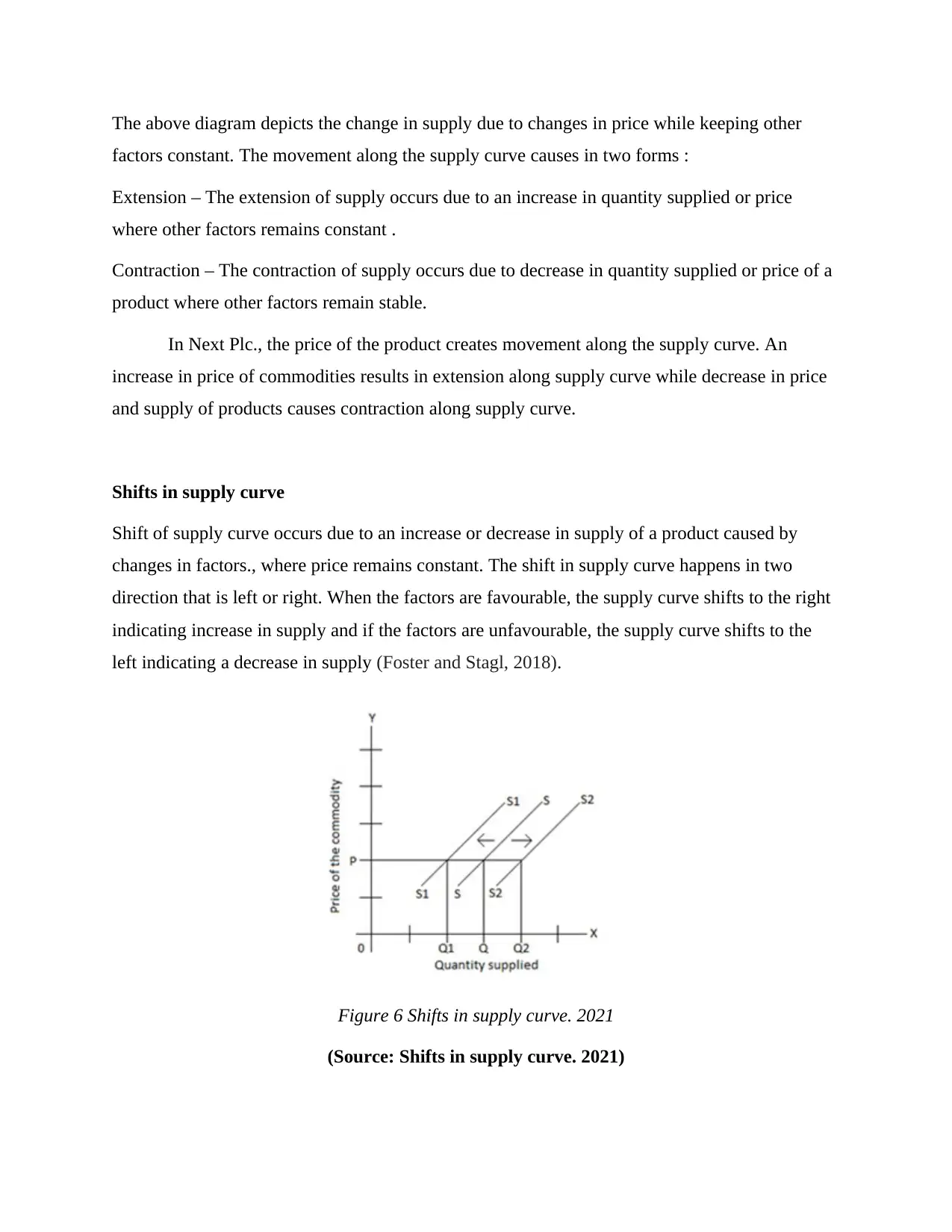
The above diagram depicts the change in supply due to changes in price while keeping other
factors constant. The movement along the supply curve causes in two forms :
Extension – The extension of supply occurs due to an increase in quantity supplied or price
where other factors remains constant .
Contraction – The contraction of supply occurs due to decrease in quantity supplied or price of a
product where other factors remain stable.
In Next Plc., the price of the product creates movement along the supply curve. An
increase in price of commodities results in extension along supply curve while decrease in price
and supply of products causes contraction along supply curve.
Shifts in supply curve
Shift of supply curve occurs due to an increase or decrease in supply of a product caused by
changes in factors., where price remains constant. The shift in supply curve happens in two
direction that is left or right. When the factors are favourable, the supply curve shifts to the right
indicating increase in supply and if the factors are unfavourable, the supply curve shifts to the
left indicating a decrease in supply (Foster and Stagl, 2018).
Figure 6 Shifts in supply curve. 2021
(Source: Shifts in supply curve. 2021)
factors constant. The movement along the supply curve causes in two forms :
Extension – The extension of supply occurs due to an increase in quantity supplied or price
where other factors remains constant .
Contraction – The contraction of supply occurs due to decrease in quantity supplied or price of a
product where other factors remain stable.
In Next Plc., the price of the product creates movement along the supply curve. An
increase in price of commodities results in extension along supply curve while decrease in price
and supply of products causes contraction along supply curve.
Shifts in supply curve
Shift of supply curve occurs due to an increase or decrease in supply of a product caused by
changes in factors., where price remains constant. The shift in supply curve happens in two
direction that is left or right. When the factors are favourable, the supply curve shifts to the right
indicating increase in supply and if the factors are unfavourable, the supply curve shifts to the
left indicating a decrease in supply (Foster and Stagl, 2018).
Figure 6 Shifts in supply curve. 2021
(Source: Shifts in supply curve. 2021)
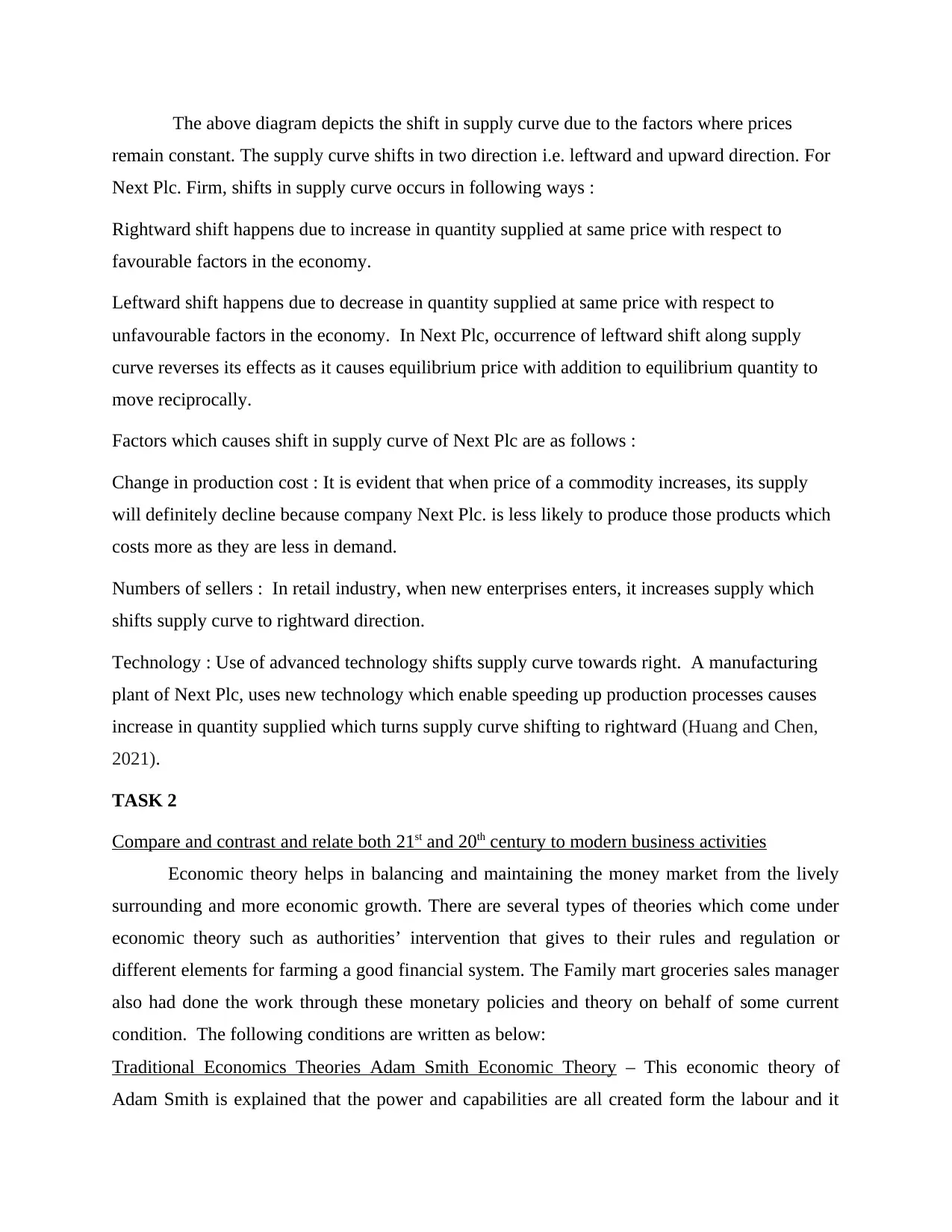
The above diagram depicts the shift in supply curve due to the factors where prices
remain constant. The supply curve shifts in two direction i.e. leftward and upward direction. For
Next Plc. Firm, shifts in supply curve occurs in following ways :
Rightward shift happens due to increase in quantity supplied at same price with respect to
favourable factors in the economy.
Leftward shift happens due to decrease in quantity supplied at same price with respect to
unfavourable factors in the economy. In Next Plc, occurrence of leftward shift along supply
curve reverses its effects as it causes equilibrium price with addition to equilibrium quantity to
move reciprocally.
Factors which causes shift in supply curve of Next Plc are as follows :
Change in production cost : It is evident that when price of a commodity increases, its supply
will definitely decline because company Next Plc. is less likely to produce those products which
costs more as they are less in demand.
Numbers of sellers : In retail industry, when new enterprises enters, it increases supply which
shifts supply curve to rightward direction.
Technology : Use of advanced technology shifts supply curve towards right. A manufacturing
plant of Next Plc, uses new technology which enable speeding up production processes causes
increase in quantity supplied which turns supply curve shifting to rightward (Huang and Chen,
2021).
TASK 2
Compare and contrast and relate both 21st and 20th century to modern business activities
Economic theory helps in balancing and maintaining the money market from the lively
surrounding and more economic growth. There are several types of theories which come under
economic theory such as authorities’ intervention that gives to their rules and regulation or
different elements for farming a good financial system. The Family mart groceries sales manager
also had done the work through these monetary policies and theory on behalf of some current
condition. The following conditions are written as below:
Traditional Economics Theories Adam Smith Economic Theory – This economic theory of
Adam Smith is explained that the power and capabilities are all created form the labour and it
remain constant. The supply curve shifts in two direction i.e. leftward and upward direction. For
Next Plc. Firm, shifts in supply curve occurs in following ways :
Rightward shift happens due to increase in quantity supplied at same price with respect to
favourable factors in the economy.
Leftward shift happens due to decrease in quantity supplied at same price with respect to
unfavourable factors in the economy. In Next Plc, occurrence of leftward shift along supply
curve reverses its effects as it causes equilibrium price with addition to equilibrium quantity to
move reciprocally.
Factors which causes shift in supply curve of Next Plc are as follows :
Change in production cost : It is evident that when price of a commodity increases, its supply
will definitely decline because company Next Plc. is less likely to produce those products which
costs more as they are less in demand.
Numbers of sellers : In retail industry, when new enterprises enters, it increases supply which
shifts supply curve to rightward direction.
Technology : Use of advanced technology shifts supply curve towards right. A manufacturing
plant of Next Plc, uses new technology which enable speeding up production processes causes
increase in quantity supplied which turns supply curve shifting to rightward (Huang and Chen,
2021).
TASK 2
Compare and contrast and relate both 21st and 20th century to modern business activities
Economic theory helps in balancing and maintaining the money market from the lively
surrounding and more economic growth. There are several types of theories which come under
economic theory such as authorities’ intervention that gives to their rules and regulation or
different elements for farming a good financial system. The Family mart groceries sales manager
also had done the work through these monetary policies and theory on behalf of some current
condition. The following conditions are written as below:
Traditional Economics Theories Adam Smith Economic Theory – This economic theory of
Adam Smith is explained that the power and capabilities are all created form the labour and it
⊘ This is a preview!⊘
Do you want full access?
Subscribe today to unlock all pages.

Trusted by 1+ million students worldwide
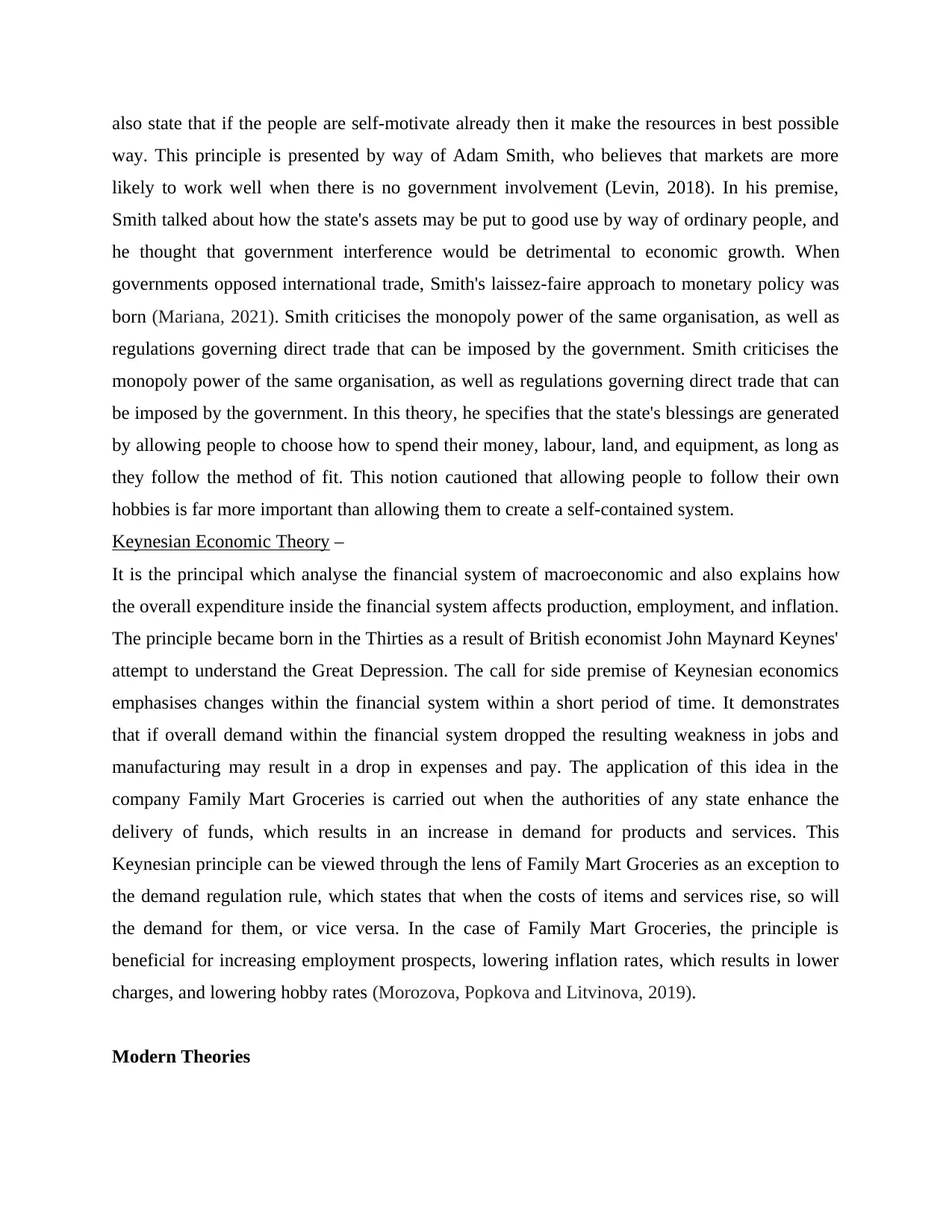
also state that if the people are self-motivate already then it make the resources in best possible
way. This principle is presented by way of Adam Smith, who believes that markets are more
likely to work well when there is no government involvement (Levin, 2018). In his premise,
Smith talked about how the state's assets may be put to good use by way of ordinary people, and
he thought that government interference would be detrimental to economic growth. When
governments opposed international trade, Smith's laissez-faire approach to monetary policy was
born (Mariana, 2021). Smith criticises the monopoly power of the same organisation, as well as
regulations governing direct trade that can be imposed by the government. Smith criticises the
monopoly power of the same organisation, as well as regulations governing direct trade that can
be imposed by the government. In this theory, he specifies that the state's blessings are generated
by allowing people to choose how to spend their money, labour, land, and equipment, as long as
they follow the method of fit. This notion cautioned that allowing people to follow their own
hobbies is far more important than allowing them to create a self-contained system.
Keynesian Economic Theory –
It is the principal which analyse the financial system of macroeconomic and also explains how
the overall expenditure inside the financial system affects production, employment, and inflation.
The principle became born in the Thirties as a result of British economist John Maynard Keynes'
attempt to understand the Great Depression. The call for side premise of Keynesian economics
emphasises changes within the financial system within a short period of time. It demonstrates
that if overall demand within the financial system dropped the resulting weakness in jobs and
manufacturing may result in a drop in expenses and pay. The application of this idea in the
company Family Mart Groceries is carried out when the authorities of any state enhance the
delivery of funds, which results in an increase in demand for products and services. This
Keynesian principle can be viewed through the lens of Family Mart Groceries as an exception to
the demand regulation rule, which states that when the costs of items and services rise, so will
the demand for them, or vice versa. In the case of Family Mart Groceries, the principle is
beneficial for increasing employment prospects, lowering inflation rates, which results in lower
charges, and lowering hobby rates (Morozova, Popkova and Litvinova, 2019).
Modern Theories
way. This principle is presented by way of Adam Smith, who believes that markets are more
likely to work well when there is no government involvement (Levin, 2018). In his premise,
Smith talked about how the state's assets may be put to good use by way of ordinary people, and
he thought that government interference would be detrimental to economic growth. When
governments opposed international trade, Smith's laissez-faire approach to monetary policy was
born (Mariana, 2021). Smith criticises the monopoly power of the same organisation, as well as
regulations governing direct trade that can be imposed by the government. Smith criticises the
monopoly power of the same organisation, as well as regulations governing direct trade that can
be imposed by the government. In this theory, he specifies that the state's blessings are generated
by allowing people to choose how to spend their money, labour, land, and equipment, as long as
they follow the method of fit. This notion cautioned that allowing people to follow their own
hobbies is far more important than allowing them to create a self-contained system.
Keynesian Economic Theory –
It is the principal which analyse the financial system of macroeconomic and also explains how
the overall expenditure inside the financial system affects production, employment, and inflation.
The principle became born in the Thirties as a result of British economist John Maynard Keynes'
attempt to understand the Great Depression. The call for side premise of Keynesian economics
emphasises changes within the financial system within a short period of time. It demonstrates
that if overall demand within the financial system dropped the resulting weakness in jobs and
manufacturing may result in a drop in expenses and pay. The application of this idea in the
company Family Mart Groceries is carried out when the authorities of any state enhance the
delivery of funds, which results in an increase in demand for products and services. This
Keynesian principle can be viewed through the lens of Family Mart Groceries as an exception to
the demand regulation rule, which states that when the costs of items and services rise, so will
the demand for them, or vice versa. In the case of Family Mart Groceries, the principle is
beneficial for increasing employment prospects, lowering inflation rates, which results in lower
charges, and lowering hobby rates (Morozova, Popkova and Litvinova, 2019).
Modern Theories
Paraphrase This Document
Need a fresh take? Get an instant paraphrase of this document with our AI Paraphraser

Nudge principle: The Nudge principle demonstrates the impact of modest suggestions and
wonderful enhancements on customer behaviour. Supporters of the nudge principle claim that
the placement of nudges is a critical issue for a business because if they are properly placed, they
will reduce market failure, keep the government's money, and help improve asset utilisation
performance. The application of the nudge principle in Family Mart Groceries stimulates
appropriate motions and improves performance in terms of asset utilisation.
Behavioural principle – Richard Thaler developed behavioural theory, which combines a
fantastic mix of psychology and economics. Employer Familiar Groceries' use of the concept in
business activities consists of using shortcuts or rules of thumb to make quick judgments. In
today's environment, businesses seek to understand that customers are irrational, and they embed
the notion for corporate decision-making standards that enrich shareholders when achieved
successfully (Mugerman and Elkin, 2019). In the Family Mart Groceries company, the
application of conventional theories is based on the notion that practical human beings devise
logical alternatives in order to maximise monetary welfare (Toye, 2018). As a result, modern
monetary theories are applied while considering factors such as spending, taxation policies, and
borrowings from fiat foreign money, which may be completely manipulate and no longer
operationally constrained via federal government sales. While the president of any state,
according to Keynesian theory, will boost the delivery of finances, this will result in an increase
in demand for products and services. However, the Adam Smith main software on Family Mart
demonstrates that allowing people to follow their own hobbies is a lot better way to create a self-
contained system. By applying traditional and modern theories to the Family Mart Groceries, it is
possible to conclude that there is one factor in unusual place in some of these theories, as they're
by some means useful in extraordinary phrases in accordance with the repute and instances of the
corporation, and allowing managers and analysts for know-how macroeconomics problems
within the financial system (Stephens and Stratford, 2018).
CONCLUSION
It is possible to deduce from the aforementioned research that demand and supply go
hand in hand in terms of economics. It is simple to comprehend the flow of services available
within the marketplace area with the aid of demand and supply law. Many factors have an impact
on the total demand for products and services within the marketplace, including product cost,
wonderful enhancements on customer behaviour. Supporters of the nudge principle claim that
the placement of nudges is a critical issue for a business because if they are properly placed, they
will reduce market failure, keep the government's money, and help improve asset utilisation
performance. The application of the nudge principle in Family Mart Groceries stimulates
appropriate motions and improves performance in terms of asset utilisation.
Behavioural principle – Richard Thaler developed behavioural theory, which combines a
fantastic mix of psychology and economics. Employer Familiar Groceries' use of the concept in
business activities consists of using shortcuts or rules of thumb to make quick judgments. In
today's environment, businesses seek to understand that customers are irrational, and they embed
the notion for corporate decision-making standards that enrich shareholders when achieved
successfully (Mugerman and Elkin, 2019). In the Family Mart Groceries company, the
application of conventional theories is based on the notion that practical human beings devise
logical alternatives in order to maximise monetary welfare (Toye, 2018). As a result, modern
monetary theories are applied while considering factors such as spending, taxation policies, and
borrowings from fiat foreign money, which may be completely manipulate and no longer
operationally constrained via federal government sales. While the president of any state,
according to Keynesian theory, will boost the delivery of finances, this will result in an increase
in demand for products and services. However, the Adam Smith main software on Family Mart
demonstrates that allowing people to follow their own hobbies is a lot better way to create a self-
contained system. By applying traditional and modern theories to the Family Mart Groceries, it is
possible to conclude that there is one factor in unusual place in some of these theories, as they're
by some means useful in extraordinary phrases in accordance with the repute and instances of the
corporation, and allowing managers and analysts for know-how macroeconomics problems
within the financial system (Stephens and Stratford, 2018).
CONCLUSION
It is possible to deduce from the aforementioned research that demand and supply go
hand in hand in terms of economics. It is simple to comprehend the flow of services available
within the marketplace area with the aid of demand and supply law. Many factors have an impact
on the total demand for products and services within the marketplace, including product cost,

buyer income, buyer selections and choices, and swings in demand in response to a dynamic
environment. There is a life of opposition between a commodity's charge and demand.
Furthermore, delivery is directly related to expenses and the amount offered as boom inside the
charge results in reduced deliver since people will require much less and will no longer be
capable of paying the accelerated charge in comparison to their disposable income. Unique
theories from the twentieth and twenty-first centuries are discussed in the report, including
Nudge theory, Behavioural theory, Adam Smith Economic theory, and Keynesian theory, as well
as their application to the given company Family Mart Groceries, as well as how they can
correctly apply those theories and their implications.
environment. There is a life of opposition between a commodity's charge and demand.
Furthermore, delivery is directly related to expenses and the amount offered as boom inside the
charge results in reduced deliver since people will require much less and will no longer be
capable of paying the accelerated charge in comparison to their disposable income. Unique
theories from the twentieth and twenty-first centuries are discussed in the report, including
Nudge theory, Behavioural theory, Adam Smith Economic theory, and Keynesian theory, as well
as their application to the given company Family Mart Groceries, as well as how they can
correctly apply those theories and their implications.
⊘ This is a preview!⊘
Do you want full access?
Subscribe today to unlock all pages.

Trusted by 1+ million students worldwide
1 out of 13
Related Documents
Your All-in-One AI-Powered Toolkit for Academic Success.
+13062052269
info@desklib.com
Available 24*7 on WhatsApp / Email
![[object Object]](/_next/static/media/star-bottom.7253800d.svg)
Unlock your academic potential
Copyright © 2020–2025 A2Z Services. All Rights Reserved. Developed and managed by ZUCOL.



